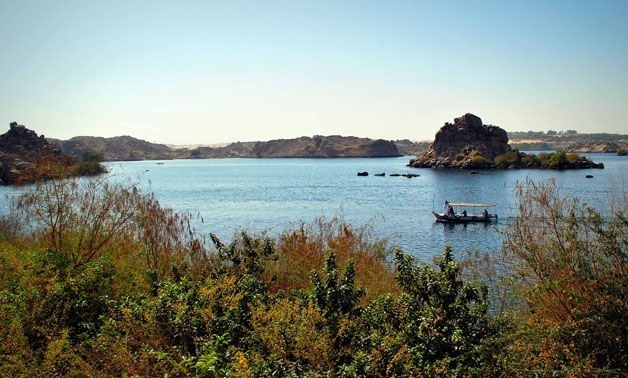
Aswan (Egypt) a branch of the Nile, seen from Isis Island March 10, 2012 – photo courtesy of Wikimedia
CAIRO – 26 April 2018: Mamdouh Raslan, chairman of Holding Company for Water & Wastewater (HCWW), said on Tuesday that the government is planning to expand water desalination plants, as well as address villages’ sewage problems.
Raslan said that this plan accommodates Egypt’s population increase, especially in the coastal cities, adding that the coverage of drinking water in Egypt is about 95 percent.
He also pointed out that the government has inaugurated the Al Yusr station in the Red Sea governorate last October and Rumaila in Marsa Matruh governorate, stressing that one station takes about one and a half years to establish.
In 2017, Minister of Housing, Utilities and Urban Development Mostafa Madbuli announced during a press conference the implementation of 16 desalination plants in five governorates: Matrouh, North and South Sinai, Red Sea and Port Said.
The minister also stressed that the establishment of desalination plants comes as a result of the state's interest in desalination of sea water in the coastal provinces to preserve Nile water for use in other activities, such as agriculture.
As part of the state's efforts to develop Sinai, al-Sayed al-Ashry, chief of the National Authority for Drinking Water and Sanitation, stressed that South Sinai governorate had the largest share in sanitation projects, which amounted to a total cost of LE 2.4 billion ($135.6 million).
Kamel al-Wazir, head of the Egyptian Armed Forces Engineering Authority, also announced in a television interview that Egypt is working on the establishment of the largest desalination plants in the world at Ain Sukhna, which will purify 164,000 cubic meters of water per day.
Egypt suffers from a water deficit of 30 billion cubic meters; it annually needs at least 90 billion cubic meters of water to cover 90 million citizens’ needs. However, it currently has only 60 billion cubic meters, of which 55.5 billion cubic meters come from the Nile and half a billion cubic meters come from non-renewable subterranean water in the deserts, said Minister of Irrigation and Water Resources Mohamed Abdel-Ati during the Egypt Can conference.
Abdel-Ati added that the Egyptian population growth is projected to increase 65-75 percent by 2050, causing a major challenge.
A further decrease in Egypt's water resources is expected in the future as a result of building the Grand Ethiopian Renaissance Dam, which will affect Egypt’s share of water.
Abdel-Ati clarified that Egypt would be affected the most by the dam established on the Blue Nile, as it is the last downstream country and because construction is taking place without prior agreement on how the dam will be operated and filled based on clear studies explaining the effects.


Comments
Leave a Comment